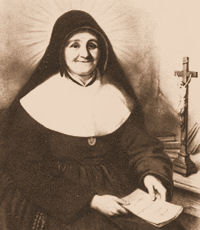Lent: April 8th
Saturday of the Fifth Week of Lent
Other Commemorations: St. Julie Billiart, Virgin (RM)
» Enjoy our Liturgical Seasons series of e-books!
According to the 1962 Missal of St. John XXIII the Extraordinary Form of the Roman Rite, in some places today is the feast of St. Julie Billiart, a French religious who founded, and was the first Superior General of, the Congregation of the Sisters of Notre Dame de Namur.
St. Julie Billiart
 Saint Julie was a woman completely immersed in God’s love and goodness, even in the midst of great suffering. She was a woman of vision who responded to the needs of the suffering world around her.
Saint Julie was a woman completely immersed in God’s love and goodness, even in the midst of great suffering. She was a woman of vision who responded to the needs of the suffering world around her.
Born in Cuvilly, France, on July 12, 1751, Julie lived a humble life in a loving family. She was a woman of serenity, despite the great personal suffering she endured. The Billiart family survived many hardships, including the deaths of several children. When Julie was 16, she went to work to help support her family. At the age of 23 she became paralyzed by the trauma of a shooting that was aimed at her father. She spent more than 20 years confined to her bed, unable to care for even her most basic needs.
Besides her physical pain, Julie suffered religious persecution, lived in hiding as a refugee. Throughout her suffering, she steadfastly trusted in God’s goodness. At the age of 53, Julie and her very good friend, Françoise Blin de Bourdon, along with two other women, made their vows as Sisters of Notre Dame in Amiens, France. A variety of difficult circumstances caused her to move her congregation to Namur, Belgium, several years later. Today these sisters are known as the Sisters of Notre Dame de Namur. Julie’s spirit and charism also influenced the Sisters of Notre Dame of Amersfoort, The Netherlands, as well as our own congregation of the Sisters of Notre Dame, which began in Coesfeld, Germany.
Julie reached out to the poor and forgotten, she brought comfort and hope to those around her, she encouraged faith in the seeking and the lost. More than anything else, she was a witness to the deep, loving goodness of God. Her motto and mantra was: “Oh, how good God is!” In 1969 Julie was named a saint by the Catholic Church. The impact that Saint Julie had on the world continues through the life and ministry of the sisters who share in her heritage.
—Excerpted from The Sisters of Notre Dame

Friday of the 5th Week of Lent
Station with St Stephen's Rotunda at the Coelian (Santo Stefano Rotondo al Celio):
The Station, at Rome, is in the church of St. Stephen on Monte Celio (the Coelian Hill). The church is dedicated first to St. Stephen, the First Martyr, but is also dedicated unofficially to St. Stephen of Hungary. This is the Hungarian national church. This church is southeast of the Colosseum, off the usual beaten path. The actual site of the church was occupied by a set of barracks housing Roman soldiers. The earliest church was consecrated by Pope Simplicius between 468 and 483. Its architecture is unique in the Late Roman world and the oldest example of a circular church, often thought that it was modelled on the Anastasis of the Holy Sepulchre in Jerusalem. Although the inside is circular, the exterior is on a cruciform plan. The church has undergone various periods of ruination, disrepair, and restoration. The relics of the first martyr were never in the church.
Besides being one of the original churches in the round, another key feature is found on the walls of the church, decorated with numerous frescoes, portraying 34 scenes of martyrdom, commissioned by Gregory XIII in the 16th century. Each painting has a titulus or inscription explaining the scene and giving the name of the emperor who ordered the execution, as well as a quotation from the Bible.
For more information, see:
Roman Churches
Great Buildings
Liturgical Arts Journal
Rome Art Lover
For further information on the Station Churches, see The Stational Church.








